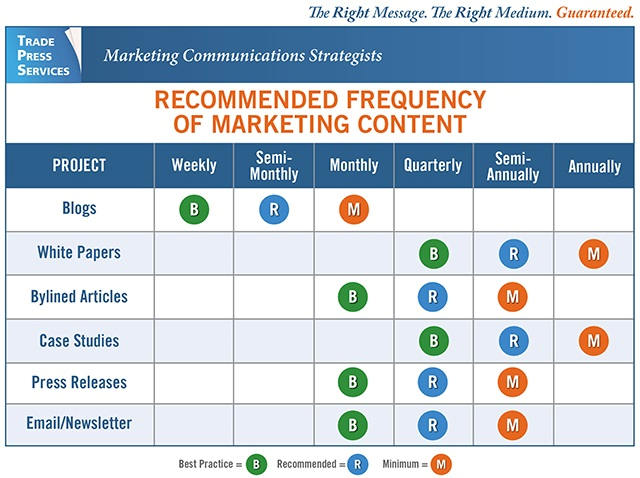
Whether you’re just starting out with content marketing or you’ve been using the tactic for a while, a strategic content marketing plan is critical to make sure your program is on target and delivers on organizational objectives. When you consider that only 42 percent of B2B marketers say they’re effective at content marketing, you can see why strong content can set your organization apart from the pack.
We’ve written several posts about how to optimize your content, best practices to follow, and what to do once your content is published. But what if you’re just getting started? Here are some helpful hints to make your job easier.
Content Marketing Program: Strategy or Tactic?
The answer is both. The foundation of any content marketing program is strategy. This involves collaboration, planning, research and exploration of possibilities to develop the overarching vision and purpose that will drive your plan. The approach you take represents your strategy, or the “what” you’re going to do. Once the strategy is in place, you can develop your tactics—the posts, platforms and frequency of outreach you intend to pursue, in other words, the “how” you will achieve your goals.
The Planning Process
We developed and use a marketing plan template to help clients create a strategic plan that, when implemented, prevents initiatives from following through the cracks. While it is broad-based, the same steps can be used to build a solid content marketing program. Here’s a recap:
1. Establish your vision and mission. When you create your content marketing program, make sure it aligns with your organization’s vision and mission. These define what success looks like and why you are in business. Use your vision and mission to make informed decisions, align departments and shape the brand of the company and employees and stakeholders within.
2. Set goals. Goals can be short- or long-term. What’s important is that they are quantifiable. How do you know if you’ve achieved success unless you have a target in mind? Consider desired platforms, frequency of posts, engagement activity, lead generation, etc.
3. Pinpoint strategies. This is the step where many organizations fall down. They don’t understand what strategy is. Some examples of a content marketing strategy include:
- Define and get to know your target audiences—where do they consume content and what type of content appeals to them?
- Look at the competition and determine what you will do differently.
- Define your competitive advantage or corporate distinction.
- Assess the quality and strength of your messaging; does it resonate?
- Choose platforms on which to engage with clients, prospects and other target audiences.
- Establish a content marketing team.
4. Identify tactics. Some content marketing tactics include social media posts on Twitter, LinkedIn, Facebook, Instagram and Pinterest. Others are longer blogs, articles, white papers, newsletters and customer success stories. Infographics, videos, live feeds, newsletters and email campaigns are additional options for your content marketing program.
5. Create a budget. Depending on the size and resources of your organization, budgets vary widely. What’s important is to make sure your budget supports your plan. If not, go back to the drawing board. Determine the priorities, and then see what you can put on hold. Look for creative ways to fund your content marketing program.
6. Put together a schedule. Use a matrix to identify the frequency and types of content you intend to produce and distribute. Some content, like blogs, may be published weekly. Social media posts will be more frequent. White papers, articles and customer success stories ideally should be created quarterly or bi-monthly. While every company has different resources (time, money and personnel), create a schedule and stick to it. If you find you need to increase the frequency, do so with the full knowledge and support of your team members.

7. Assign responsibilities. Once your budget is approved and you have a schedule, it’s time to assign responsibilities. Determine who on your team is responsible for content creation, graphic design, production, distribution, etc. Make sure deliverables are clear and expectations are communicated. Create back-up plans for the unexpected or when current resources go on overload.
8. Develop a monitoring, evaluation and modification process. Part of the success of any plan, including a content marketing plan, depends on having a mechanism to measure progress. Whether you use tech-based analytics or a more hands-on approach, determine how frequently to evaluate your efforts. Figure out what’s working and what’s not, and then refine your plan accordingly.
Focus on Others
With a content marketing plan in place, remember the objective is to appeal to the needs and interests of your audiences. According to Melih Ozataly, CEO of Smart Finds Marketing, “Your prospective customers enjoy being educated. When you tap into this need and desire by sharing your knowledge and expertise, you will earn the position and reputation as a trusted and respected advisor in your subject matter. This role as a thought leader puts you above the competition.”
Working Together

Successful content marketing doesn’t happen on its own. To get results, you need a written plan. But for many marketers, the process of creating the plan presents the biggest challenge. While it might take some time and requires effort, it’s well worth the investment of resources. The process of creating a content marketing plan builds alignment, engagement and puts everyone on the same page for the year to come. When everyone works together toward a common goal, the likelihood of success compounds exponentially.


